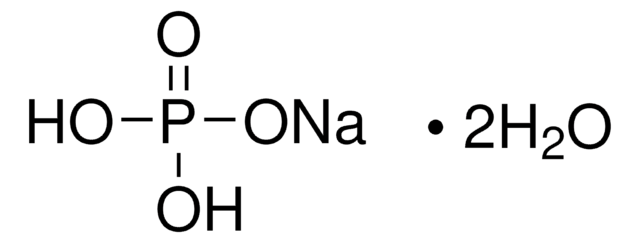04272
di-Sodium hydrogen phosphate dihydrate
meets analytical specification of Ph. Eur., BP, 98.5-101% (calc. to the dried substance)
Synonym(s):
sec-Sodium phosphate, Disodium hydrogen phosphate dihydrate, Disodium phosphate, Sodium phosphate dibasic dihydrate
About This Item
Recommended Products
Agency
meets analytical specifications of BP
meets analytical specifications of Ph. Eur.
Quality Level
Assay
98.5-101% (calc. to the dried substance)
form
crystals
quality
meets analytical specification of Ph. Eur., BP
impurities
reducing matter, complies
residual solvents, complies
≤0.001% heavy metals (as Pb)
≤1% NaH2PO4 (calc. to dried subst.)
loss
19.5-21% loss on drying, 130 °C
pH
9.0-9.4 (20 °C, 1%)
anion traces
chloride (Cl-): ≤50 mg/kg
sulfate (SO42-): ≤100 mg/kg
cation traces
As: ≤2 mg/kg
Fe: ≤10 mg/kg
suitability
complies for appearance of solution
SMILES string
O.O.[Na+].[Na+].OP([O-])([O-])=O
O.O.[Na+].[Na+].OP([O-])([O-])=O
InChI
1S/2Na.H3O4P.2H2O/c;;1-5(2,3)4;;/h;;(H3,1,2,3,4);2*1H2/q2*+1;;;/p-2
InChI key
KDQPSPMLNJTZAL-UHFFFAOYSA-L
Looking for similar products? Visit Product Comparison Guide
Application
Biochem/physiol Actions
Storage Class Code
13 - Non Combustible Solids
WGK
WGK 1
Flash Point(F)
Not applicable
Flash Point(C)
Not applicable
Choose from one of the most recent versions:
Already Own This Product?
Find documentation for the products that you have recently purchased in the Document Library.
Our team of scientists has experience in all areas of research including Life Science, Material Science, Chemical Synthesis, Chromatography, Analytical and many others.
Contact Technical Service

